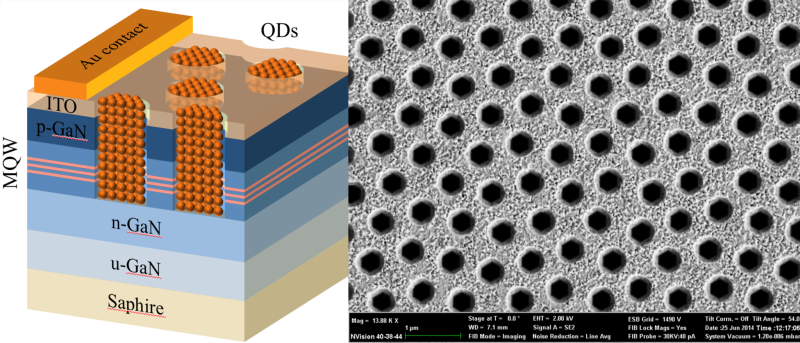An international team of scientists from the Center for Photonics and Quantum Materials, Skolkovo Institute of Science and Technology (Russia), School of Electronics and Computer Science and the School of Physics and Astronomy at the University of Southampton (UK), Luxtaltek Corporation (Taiwan), the Department of Photonics & Institute of Electro-Optical Engineering and National Chiao Tung University (Taiwan) has designed a novel photonic LED structure with record-breaking color conversion and effective quantum yields (ratio of the number of photons emitted to the number of photons absorbed.). This new technology provides an exciting new technological avenue towards ultra-thin low cost LEDs.
In standard white LED configurations, color convertors (typically phosphors) are dispersed into an encapsulation layer above a blue GaN (gallium nitrate) LED chip. These emitters absorb blue light and emit photons at higher wavelength to produce a white spectrum pleasing to the eye. In this configuration, only photons escaping the GaN stack can be absorbed by the emitter, while a large portion of the emitted blue light remains trapped in the outer layers. This strongly limits the efficiency of such LEDs. In this paper, the authors introduce a novel hybrid architecture that utilizes photonic crystals etched deep into the active area of the LED (see Fig. 1), which drastically improves the properties of the device by allowing more light to come out of the chip. Quantum dots (QDs) color converters can then be integrated into the nano-holes so as to generate white light.

Fig.1. Schematic representation and top scanning electron microscope view of a photonic crystal LED (pictures from the publication).
“The excellent coupling between the blue emission from the GaN LED and the QD emitters provides record color conversion effective quantum yields, a key metric for white light LEDs. This allows us to completely remove the encapsulation epoxy that typically contains the white phosphors to obtain ultra-thin LED devices. These structures would be much easier to integrate into typical edge-lit LED screens, lowering the overall cost. This approach gives us a lot of control on the directionality of the light emission, which could improve the coupling into the light waveguides of LED screens, lowering power consumption. These structures were also produced using low-cost fabrication techniques, such as nano-imprinting, which makes them very appealing to the lighting industry,” says Dr Mael Brossard, one of the authors of this research, a scientist from the Skoltech Center for Photonics and Quantum Materials.
Scientists are currently fine-tuning the LED architecture, with a special focus on novel complex photonics crystal geometries. Discussions are also on-going with industrial partners, and the possibility of integrating these LEDs into real-world devices is being investigated.
The results were presented in Optica, an open-source journal of The Optical Society of America.
* The Skolkovo Institute of Science and Technology (Skoltech) is a private graduate research university in Skolkovo, Russia, a suburb of Moscow. Established in 2011 in collaboration with MIT, Skoltech educates global leaders in innovation, advances scientific knowledge, and fosters new technologies to address critical issues facing Russia and the world. Applying international research and educational models, the university integrates the best Russian scientific traditions with twenty-first century entrepreneurship and innovation.
Contact information:
Skoltech Communications
+7 (495) 280 14 81
